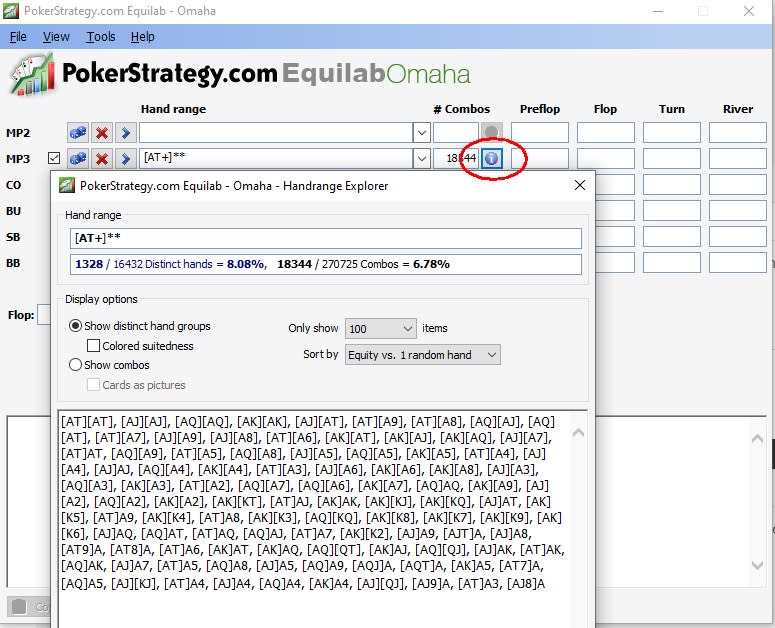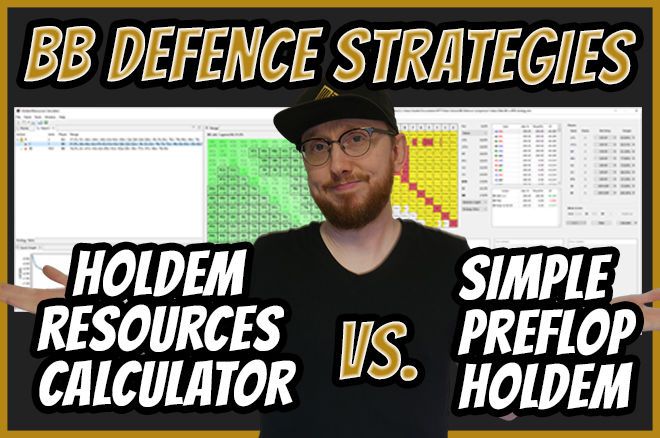I think it’s time to give the PokerStrategy Equilab software a proper review. I used to use PokerStove but I switched to Equilab as I think it has a few edges on the former and is more well made. Equilab suits the beginniner, intermediate and proficient poker players really well. It has got me to understand a lot of situations and I have spent countless hours in it, either calculating spots in hands that I thought at the time were close, or learning about certain ranges’ equity in different spots. As a coach I also use it to make ranges for my students in an easy to read format that saves them time. Finally, a really nice feature of the software is that it has an equity trainer which you probably didn’t know about!
All in all, I think this is a really good piece of software and that’s why I’m writing this article. The hours put into the study of hands that seem really close will improve your game as a poker player to the next level. Let me show you some interesting things that you can do with it:
Fast equity calculations - key to poker success
Whenever you need to study a hand as intrinsically as possible, the equity calculator is exactly where you need to go.
Basically, equity means your chance of winning a pot in a given situation. The Power-Equilab can analyse the range of hands an opponent will likely hold in a given situation, then provide you with equity figures so you can deduce the profitability of any given situation. Please check out the various Features, that Power-Equilab provide. Equilab from PokerStrategy.com initially appeared on the scene as a hand vs hand and hand vs range replacement to PokerStove, when the latter left the market. The free version was later extended to the more complex and versatile Power-Equilab, as well as the free Equilab Omaha.
Equilab saved me a lot of time because I could not only select hands from the range by clicking them, I could actually drag the mouse while holding left click and select a wide array of hands, just like playing Snake.
Pre-defined hand ranges
are the predefined hand ranges. I was delighted to see this when I first started to try out this software several years ago, because it saves you a lot of time by assigning default ranges to opponents, ranges that were presented by several respectable coaching sites, so they’re legit, made by actual poker players/coaches. No 30% BTN! Have a look see:

This is a ShortHanded(SH) Loose opening range, and you can select a lot more, they just save time because if you want to assign a certain range to a player that opens from the button aggressively, you don’t have to put in all the hands that he’d steal with, you just have to assign a Loose, Tight or Standard raise.
Equilab Holdem Games
Another way to do this is by using the slider and assigning his exact steal % rom the BTN, so if he steals 50% and it’s a solid stat because you have a lot of hands on the guy, you can easily see what hands that amounts to. In the Power Equilab version that can be
 found here
found here (you can download a free trial to test it out), you can actually select the Hand ranking table that you want, and there’s some really useful ones there. So basically, when you use the slider to make up 50% of the range, it’s gonna use the top 50% hands in that range table.
Let's construct a range
Let me show you how to easily construct a range here. Of course, usually we keep either the Sklansky-Malmuth groups, or the Equity vs Random 1 hand, because that’s supposed to be the best, right ? Well, let’s say if you’re UTG in a 9-max FR game, and you’re thinking you want to construct your opening range for this position. Would it not make sense to take the hand ranking table for “Equity vs 8 random hands”? It most definitely would, you’re right on track. So, after selecting the table, just click on OK and now it’s time to decide how much do we need to open from UTG? Are we playing soft games or will our opponents be 3-bet bluffing us a lot with blockers? Let’s try to put in 12% opening range UTG.
There we go! Although I don’t recommend raising ATo as part of your 12% UTG opening range, it’s better against 8 randoms than, let’s say, A7s. It makes sense because it’s blocker heavy and as long as you don’t go overboard with it, everything will be fine and dandy. I’d actually take it out and raise all pairs instead because we just get so much respect raising UTG in 9-max and a lot of folds to C-bets, so when you get called, most of the time with ATo you’re way behind, but with pairs when you get a set, you’re unbeatable most of the time.
You can also use weights in this, for example if you want to assign to a villain that he might be 3-betting 50% of the time KQo you can just use the weight function. This is also only available in the Power Equilab version.
Equilab Holdem Strategy

Equity Trainer - Real Scenarios
Going forward, I promised I’d show you the Equity Trainer and I think this is really beneficial to a poker player’s understanding of preflop situations, and if you do this often enough, you’ll see that this will expand your horizons. You’ll start raising more, you’ll start 3-betting a lot looser and fear opponents that open especially from late positions a lot less.
Let me give you an example on how this works. This is not only for No Limit Hold’em, but for Fixed Limit and Sit’n’Go and implicitly MTT’s also.
Here you select exactly what equity situations you want to train in:
Let’s take for example No Limit Big blind defense vs BU open-raise. This is imperative to be known by heart, because it’s a real eye-opener to the amount you should be defending your blinds and the ranges you need to do this with. Here’s an example:
The button opening range is assigned by default, but you can change it to your needs.
I almost got it! So you see, K9o is really very close to 50% against the BTN’s opening range. So why not 3-bet it? It could get you into a pickle if you get called, but you can find other hands like A3s and K8s to be fairly similar in equity and easier/better to play postflop in 3-bet pots.
If you also want to play it cool like you’re using FlopZilla, you can check the Flop/Turn/River boxes and fair your knowledge of K9 for example on a T73 board. You’ll be super surprised of the results and how often you’re ahead, and if your opponent has a bad habit of C-betting a lot, you can just reverse-float OOP and maybe take it away on later streets, OR raise him because you’re getting an insane amount of folds.
Another really useful thing here that shed a lot of light on my poker math was the Poker mathematics tool, where you just type in the numbers and it magically gives you the solution, using the formulas that are also displayed below. Let’s try to calculate the fold frequency that we need when opening 2x from the BTN, which we just do by entering the numbers in the Fold Frequency screen:
This is a really powerful tool, because it allows you to read opponent’s stats and then, if you know these numbers by heart, evaluate the spots in which you can raise ATC(Any Two Cards), or ~80% of your range to exploit your opponents and win a lot of money in the long run by just stealing his blinds a lot and not going overboard postflop. The software goes a lot further than that, offering a lot of choices, as you can read all the tabs above. I personally like Facing 3bet, but I’ll let you guys discover that one on your own. It’s a game changer!
- Heatmaps
- Equity Graphs
- Scenario Analyzer
- Playabilities
- Import Hand History
Downloads
- Download PowerEquilab free here.
Safety Tracking lets someone follow your ride live from their phone until you are back safe. Equilab shares your position and information about your ride, so if something happens you, they who follow you will see exactly where you are on the map.
To setup Safety Tracking you go into the safety tracking tab, accessible from the start view or in settings. The first thing you have to do is to turn on the Safety Tracking, this will turn the safety tracking symbol orange in the start screen as well.
In the safety tracking view you can choose between two different ways of sharing your ride:
Safety Contacts
This requires that you friends have created accounts in the app. You thereafter need to become friends with them in the app. You can add friends by pressing the add friends symbol in the friends tab. After you have become friends you can add them as safety contacts in the safety tracking view. Your friends will thereafter get a notification each time you start/stop a ride and be able to access the trainings live from the friends tab
Safety Tracking Links
When Safety Tracking is turned on a link button will pop up on the left side of the safety tracking button in the start view. By pressing this you will given a link that you can share through your favorite communication app. By pressing this link your friends will be able to follow your ride through any web browser.

 found here (you can download a free trial to test it out), you can actually select the Hand ranking table that you want, and there’s some really useful ones there. So basically, when you use the slider to make up 50% of the range, it’s gonna use the top 50% hands in that range table.
found here (you can download a free trial to test it out), you can actually select the Hand ranking table that you want, and there’s some really useful ones there. So basically, when you use the slider to make up 50% of the range, it’s gonna use the top 50% hands in that range table. 